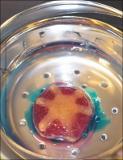| dc.contributor.author | D'Angelo, Greta | |
| dc.contributor.author | Hansen, Hans N. | |
| dc.contributor.author | Hart, A. John | |
| dc.contributor.author | Hart, Anastasios John | |
| dc.date.accessioned | 2018-02-21T16:22:33Z | |
| dc.date.available | 2018-02-21T16:22:33Z | |
| dc.date.issued | 2016-09 | |
| dc.identifier.issn | 2329-7662 | |
| dc.identifier.issn | 2329-7670 | |
| dc.identifier.uri | http://hdl.handle.net/1721.1/113849 | |
| dc.description.abstract | The potential use of additive manufacturing (AM) techniques for processing of food can span from satisfaction of basic necessities to high-end cuisine and fine dining. The purpose of this study was to explore how AM, specifically extrusion-based layer-wise deposition, can be combined with the reverse spherification technique that is widely used in molecular gastronomy. First, by manual extrusion, we identify suitable recipes and ingredient concentrations to form freestanding features in a liquid bath. Subsequently, a desktop extrusion is adapted for the deposition of a calcium solution into an alginate bath first as a two-dimensional (2D) pathway and then as three-dimensional (3D) geometry by layer-wise deposition. The 2D geometries are measured and compared to a nominal geometry, to elucidate how tool speed and extrusion rate influence form and dimensional accuracy. We demonstrate that motorized extrusion-based AM can be combined with reverse spherification to form stable objects by gelation of fruit-based solutions. In addition, a wider set of manual experiments shows the possibility of combining different flavors and the creation of complex multilayer and multiflavor objects. Additional studies on the deposition precision are required to optimize the process of creating a full 3D geometry. This study shows that 3D printing via reverse spherification can bridge the gap between culinary art and AM technology, and enable new capabilities for creation of dining experiences. This is a step toward the digital design and manufacturing of unique edible objects with complex flavors, textures, and geometries. | en_US |
| dc.publisher | Mary Ann Liebert Inc | en_US |
| dc.relation.isversionof | http://dx.doi.org/10.1089/3DP.2016.0024 | en_US |
| dc.rights | Article is made available in accordance with the publisher's policy and may be subject to US copyright law. Please refer to the publisher's site for terms of use. | en_US |
| dc.source | Mary Ann Liebert | en_US |
| dc.title | Molecular Gastronomy Meets 3D Printing: Layered Construction via Reverse Spherification | en_US |
| dc.type | Article | en_US |
| dc.identifier.citation | D’Angelo, Greta et al. “Molecular Gastronomy Meets 3D Printing: Layered Construction via Reverse Spherification.” 3D Printing and Additive Manufacturing 3, 3 (September 2016): 152–159 © 2016 Mary Ann Liebert, Inc | en_US |
| dc.contributor.department | Massachusetts Institute of Technology. Department of Mechanical Engineering | en_US |
| dc.contributor.mitauthor | Hart, Anastasios John | |
| dc.relation.journal | 3D Printing and Additive Manufacturing | en_US |
| dc.eprint.version | Final published version | en_US |
| dc.type.uri | http://purl.org/eprint/type/JournalArticle | en_US |
| eprint.status | http://purl.org/eprint/status/PeerReviewed | en_US |
| dc.date.updated | 2018-02-16T18:40:42Z | |
| dspace.orderedauthors | D'Angelo, Greta; Hansen, Hans N.; Hart, A. John | en_US |
| dspace.embargo.terms | N | en_US |
| dc.identifier.orcid | https://orcid.org/0000-0002-7372-3512 | |
| mit.license | PUBLISHER_POLICY | en_US |
